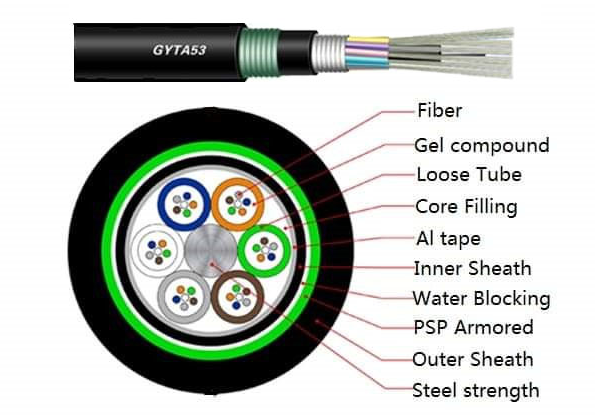The structure of the direct-buried optical cable is that single-mode or multi-mode optical fiber is sheathed in a loose tube made of high-modulus plastic filled with waterproof compound. The center of the cable core is a metal reinforced core. For some fiber optic cables, the metal reinforced core is also extruded with a layer of polyethylene (PE). The loose tube (and filling rope) is twisted around the central reinforcing core to form a compact and circular cable core, and the gaps in the cable core are filled with water blocking compounds. The cable core is extruded with a layer of polyethylene inner sheath, and the double-sided plastic coated steel tape is longitudinally wrapped and then extruded with a polyethylene sheath.
Features:
1. Precise control of the excess length of the optical fiber ensures that the optical cable has good tensile performance and temperature characteristics.
2. The PBT loose tube material has good hydrolysis resistance, and the tube is filled with special grease to protect the optical fiber.
3. It has excellent compression resistance.
4. The smooth outer sheath enables the optical cable to have a smaller coefficient of friction during installation.
5. Use the following measures to ensure the waterproof performance of the optical cable: the loose tube is filled with special waterproof compounds; the cable core is completely filled; the plastic-coated steel belt is moisture-proof.
Today, GL fiber will share some precautions for the protection of directly buried optical cable lines.
1. Prevent Mechanical Damage
Directly buried optical cables are buried underground, and the external environment in which the optical cable routing is located is particularly complicated. If adequate protection measures are not made, more security risks will inevitably be buried, which is not conducive to the operation and maintenance of communication networks. The first consideration in fiber optic cable protection is to prevent mechanical damage. According to different geological environments, different protective measures should be adopted. Take Inner Mongolia as an example. Inner Mongolia has a large amount of rural arable land. When passing through these places, use bricks, steel pipes or plastic pipes with a diameter of 38mm/46mm to protect.
2. Lightning Protection
Lightning protection for directly buried optical cables should be done: first, adopt physical lightning resistance methods, and use high-level insulating protective sleeves to improve the insulation capacity and resistance to electric shocks of optical cables; second, improve the awareness of lightning protection safety work, in the early stage of construction During the survey and maintenance in the later stage of construction, especially in the beginning of construction, do a good job of lightning protection. Such as the use of lightning protection ground wire, arc suppression wire, lightning rod and other equipment. Avoid lightning-prone targets such as isolated trees, towers, tall buildings, street trees, and woods. For places where lightning damage occurs frequently, the optical cable can adopt a non-metallic reinforced core or a structure without metal components.
3. Moisture-proof and anti-corrosion
The optical cable jacket has good moisture-proof performance and strong moisture-proof function. What needs attention is the moisture resistance and insulation of the joint box. The landfill of optical fiber cables should also bypass toilets, septic tanks, tombs, chemical areas, etc.


